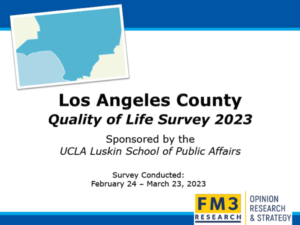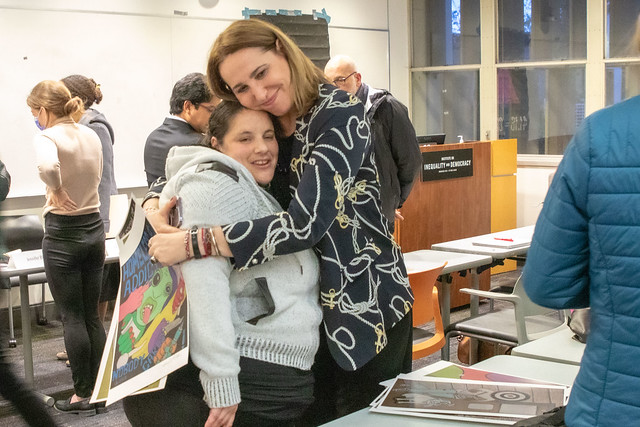L.A. County Residents Express Second-Lowest Satisfaction Ever With Quality of Life Despite overall uptick in eighth annual index, dissatisfaction remains high due to inflation, homelessness and the COVID-19 pandemic
By Les Dunseith
Los Angeles County residents are feeling more upbeat today than a year ago — but not by much.
Inflation remains a primary concern as people worry about losing their homes or feeding their families. Many residents said their quality of life had been affected by a homeless encampment. And they believe the pandemic’s impacts on L.A. life will be long-lasting.
Those are just a few of the key takeaways from the latest Quality of Life Index, or QLI, a project of the Los Angeles Initiative at the UCLA Luskin School of Public Affairs that measures county residents’ satisfaction levels in nine categories. The overall rating rose two points to 55, but it was still the second-lowest rating in the eight years of the project. The highest rating of 59 was recorded in 2016 and 2017.
“Last year’s record negativity appears to have bottomed out and made a slight upward turn,” said Zev Yaroslavsky, director of the Los Angeles Initiative, who oversees the index. “But inflation has taken a toll, especially among lower- and middle-income residents.”
In fact, 94% of respondents said they were affected by inflation and the increase in costs of basic needs. And 71% said it had a major impact. Rising housing costs were an issue for 82% of respondents, and 58% said it’s a major concern.
More than a quarter, or 28%, of respondents worried about losing their home and becoming homeless, while 25% were afraid their families will go hungry because they can’t afford the cost of food. Nearly half of people in households earning less than $60,000 were concerned about becoming homeless.
Almost three-quarters of residents, 73%, said their quality of life had been impacted in the last year by a homeless encampment. A major impact was reported by 43% of respondents, with San Fernando Valley and Westside residents at 50% and San Gabriel Valley residents at 28%.
Most respondents, 75%, said life has been fundamentally changed by the COVID-19 pandemic. Only 23% expect life to return to the way it was before.
Of survey respondents who are employed, 49% said they always work away from home, 36% divide their work between home and a workplace, and 14% always work from home. Lower-income residents were far more likely to always work away from home, 61%, than higher-income households, 39%. Hybrid schedules were more common for higher-income workers, 41%, compared to 29% for lower-income households.
Many respondents said their income changed during the pandemic, with 27% saying it went down and 30% saying it went up. More than a third, or 35%, of those with a household income below $60,000 said it declined. Nearly half, or 45%, of respondents with a household income over $120,000, said it rose.
“The income disparities that have defined the Southern California economy for several decades have been exacerbated by COVID, as the rich seem to be getting richer while the poor are getting poorer,” Yaroslavsky said. “County residents whose incomes have not rebounded have less money than they used to, and what they have doesn’t buy what it did before. They’re getting hurt coming and going.”
This year’s QLI was based on interviews conducted with 1,429 county residents over 30 days beginning on Feb. 24. The survey has a margin of error of plus or minus 2.6%.
Ratings were up slightly in all nine categories except health care, which remained the same as 2022 at 66.
Among the other results:
- Cost of living, which is always the lowest rated, increased to 41 from 39. White respondents gave it a 37, among the lowest in any category in the survey’s history.
- Also scoring below the survey’s midpoint of 55 were education, 48, and transportation and traffic, 53.
- Public safety, jobs and the economy, and the environment came in at 58.
- Race and ethnic relations, 67, and their neighborhood, 68, were the top-rated categories.
The survey also examined approval ratings for local elected officials. Los Angeles Mayor Karen Bass had the highest favorability, with 46% of all respondents viewing her favorably and 23% unfavorably. City of L.A. respondents were even more positive, with 51% favorable and 17% unfavorable.
Sheriff Robert Luna was rated 37% favorable and 21% unfavorable. Los Angeles Police Chief Michel Moore received a 31% favorable and 22% unfavorable rating.
County Public Health Director Barbara Ferrer was viewed favorably by 34% and unfavorably by 20%, with respondents ages 65 and older giving her a 47% favorable rating. Meanwhile, ratings for District Attorney George Gascón improved somewhat from last year but were still negative — 27% of county residents view him favorably, compared to 40% who view him unfavorably. Last year, the result was 22% favorable, 44% unfavorable.
The Quality of Life Index is funded by the Los Angeles Initiative and Meyer and Renee Luskin. The full report will be released on April 19 as part of UCLA’s Luskin Summit, which is being held in the Faculty Center at UCLA. In addition to a presentation by Yaroslavsky, L.A. City Council President Paul Krekorian will deliver a keynote address. A series of breakout discussions on issues of public concern will precede a closing session on the local homelessness emergency featuring state, county and city officials. The full agenda for Luskin Summit 2023 is available online.
The QLI was prepared in partnership with the public opinion research firm FM3 Research.
View the report and other information about this year’s study, plus previous Quality of Life Indexes, on the website of the UCLA Lewis Center for Regional Policy Studies.



